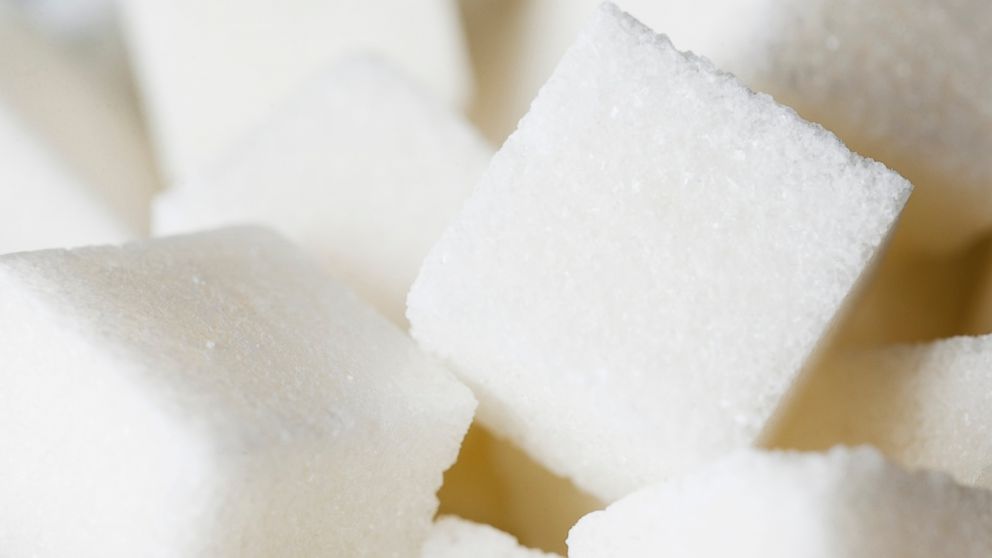7 Surprising Reasons to Give Up Sugar
It's making fat show up in really weird places, for starters.

Jan. 26, 2014— -- intro:Sugar was always meant to be a treat, a reward. "The last time I checked, birthday cake was for birthdays, and birthdays come once a year," says endocrinologist Robert Lustig, MD, author of Fat Chance: Beating the Odds Against Sugar, Processed Food, Obesity, and Disease. But added sugar is infiltrating the food supply, and we're not just talking soda here. Food manufacturers pump excess sugar into an array of foods—even "health foods"—creating catastrophic health results. Is sugar toxic? The added sugars are. Learn where this type of sneaky sugar hides, along with these surprising sugar side effects.
11 Weird Things Sugar is Doing To Your Body
quicklist: 1 category:Sugar Shockerstitle:You're overdosing on it.url:text:The Facts: Americans swallow a whopping 13 percent of their daily calories from added sugars. That adds up to about 130 pounds per year. Break that down to the daily level, and we're way over the limit, downing the equivalent of 22 teaspoons of added sugars a day. According to the American Heart Association, women should max out at the equivalent of 6 teaspoons of added sugars daily; men should stop at 9.
We can't completely blame the fast-food industry, either. A recent National Health and Nutrition Examination Survey report found the majority of added sugar intake—67 percent—occurred at home.
Where Sugar Lurks: Salad dressings may not taste sweet, but the food industry often adds sugar to low-fat versions to make them more palatable. Try vinegar and olive oil instead. While shopping, look for brands like Organicville that are made with no added sugars.
quicklist: 2 category:Sugar Shockerstitle:It tricks your brain.url:text:The Facts: Eating too much added sugar allows the fructose found in sugar and high-fructose corn syrup to send your hunger hormones into a tailspin. The hormonal messages that tell your brain you're full aren't properly triggered, tricking your system into thinking you haven't eaten, Dr. Lustig explains.
Where Sugar Lurks: Surprisingly, in bread—and not just white bread, either. Multigrain and whole wheat generally contain about 2 grams of added sugar per slice.
quicklist: 2 category:Sugar Shockerstitle:It accelerates aging.url:text:The Facts: "Sugar is a primary contributor to the aging process," Dr. Lustic explains. He says fructose, the sweet molecule in sugar, is seven times more potent than the glucose portion of sugar, forming oxygen radicals, leading to higher rates of cell damage and death, and contributing to chronic diseases like type 2 diabetes and heart disease. It speeds along the aging process in general.
Where Sugar Lurks: You wouldn't guess it, but added sugar hides out in most tomato sauces. "The problem is that the Institute of Medicine, United States Department of Agriculture, and Food and Drug Administration refuse to list a Dietary Reference Intake—a maximum—for sugar consumption," Dr. Lustig says. "That gives the food industry license to put any amount into any food they want. With no Daily Recommended Intake, you can't know if you're over the top."
7 Sinister Food Industry Tricks
quicklist: 3category:Sugar Shockerstitle:It "browns" your tissues.url:text:The Facts: In a way, we "rust" as we age. Oxidative stress turns our tissues "brown;" this is known as the Maillard reaction. Chronically overindulging in excess added sugar will speed up this browning process.Where Sugar Lurks: It's in most processed foods. Of the estimated 600,000 commercial food products, about 80 percent contain added sugar, Dr. Lustig says. Sodas, fruit juices, and desserts account for only about half of those, so cooking from scratch can help you get a grip on your sugar intake.
quicklist: 4category:Sugar Shockerstitle:It makes your liver fat.url:text:The Facts: When you overdose the mitochondria in your liver with sugar, the organ has no choice but to take the excess and turn it into liver fat. Some of this fat never makes it out of the liver, leading to nonalcoholic fatty liver disease. This forces the pancreas to make extra insulin so the damaged liver can do its job.
The organ fat buildup isn't necessarily obvious on the outside, either. A 2012 study in the Journal of Clinical Nutrition found people who ate 1,000 extra calories of sugary foods saw just a 2 percent increase in body weight, but a 27 percent increase in liver fat.
Where Sugar Lurks: Be sure to check sugar content in yogurt—some are loaded with sugar, with amounts comparable to a candy bar! Look for yogurt with sugar levels well under 10 grams per serving, such as Stonyfield's Greek.
9 Disturbing Side Effect of Soda
quicklist: 5category:Sugar Shockerstitle:It makes you an addict.url:text:The Facts: Dopamine is one your body's feel-good neurotransmitters. But eating too much fructose shuts down healthy signaling in the body, meaning it takes more and more sugar to fire off signals that bring pleasure.Where Sugar Lurks: Beware packaged smoothies—some tout higher sugar levels than an ice cream sundae! To take control, make your own homemade smoothies.
quicklist: 6category:Sugar Shockerstitle:It annihilates your arteries..url:text:The Facts: Over time, that bad habit of eating too much added sugar will start seriously irritating your endothelium, the sheath of special cells coating the inside of your blood vessels. Glucose glops up on the fingerlike feelers of the cells, making them less sensitive, which could impact oxygen sent to your organs.
Where Sugar Lurks: Even meat products in the frozen food aisle could harbor hidden sugars. Leave the TV dinners at the store. Take the time to cook a large batch of whole foods over the weekend and enjoy them all week to help you evade unwanted sugars.